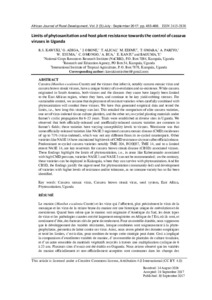| dc.contributor.author | Kawuki, Robert S. |
| dc.contributor.author | Adiga, G. |
| dc.contributor.author | Orone, J. |
| dc.contributor.author | Alicai, Titus |
| dc.contributor.author | Edimu, M. |
| dc.contributor.author | Omara, T. |
| dc.contributor.author | Pariyo, A. |
| dc.contributor.author | Esuma, W. |
| dc.contributor.author | Omongo, C. |
| dc.contributor.author | Bua, A. |
| dc.contributor.author | Kanju, E. |
| dc.contributor.author | Baguma, Yona K. |
| dc.date.accessioned | 2019-12-04T11:14:24Z |
| dc.date.available | 2019-12-04T11:14:24Z |
| dc.date.issued | 2017-07 |
| dc.identifier.citation | Kawuki, R.S., Adiga, G., Orone, J., Alicai, T., Edimu, M., Omara, T., ... & Kanju, E. (2017). Limits of phytosanitation and host plant resistance towards the control of cassava viruses in Uganda. African Journal of Rural Development, 2(3), 455-466. |
| dc.identifier.issn | 2415-2838 |
| dc.identifier.uri | https://hdl.handle.net/20.500.12478/2754 |
| dc.description | Published online: 30 Sept 2017 |
| dc.description.abstract | Cassava (Manihot esculenta Crantz) and the viruses that infect it, notably cassava mosaic virus and cassava brown streak viruses, have a unique history of co-evolution and co-existence. While cassava originated in South America, both viruses and the diseases they cause have largely been limited to the East African region, where they have, and continue to be key yield-robbing stresses. For sustainable control, we assume that deployment of resistant varieties when carefully combined with phytosanitation will combat these viruses. We have thus generated empirical data and tested the limits, i.e., how long this strategy can last. This entailed the comparison of elite cassava varieties, one set of virus-indexed tissue culture plantlets, and the other set, re-cycled planting materials under farmer’s cyclic propagation for 6-23 years. Trials were established at diverse sites in Uganda. We observed that both officially-released and unofficially-released cassava varieties are common in farmer’s fields; these varieties have varying susceptibility levels to viruses. Worrisome was that some officially-released varieties like NASE 3 registered cassava mosaic disease (CMD) incidences of up to 71% (virus-indexed), which was not any different from its re-cycled counterparts. Other varieties like NASE 14 have maintained high levels of CMD resistance six years after official release. Predominant re-cycled cassava varieties notably TME 204, I92/0057, TME 14, and to a limited extent NASE 14, are key reservoirs for cassava brown streak disease (CBSD) associated viruses. These findings highlight the limits of phytosanitation, i.e., in areas like Kaberamaido associated with high CMD pressure, varieties NASE 1 and NASE 3 can not be recommended; on the contrary, these varieties can be deployed in Kalangala, where they can survive with phytosanitation. And for CBSD, the findings justify the urgent need for phytosanitation (community-led) and development of varieties with higher levels of resistance and/or tolerance, as no immune variety has so far been identified. |
| dc.format.extent | 455-466 |
| dc.language.iso | en |
| dc.subject | African Cassava Mosaic Virus |
| dc.subject | Cassava |
| dc.subject | Phytosanitation |
| dc.subject | Seed System |
| dc.subject | Cassava Brown Streak Disease |
| dc.subject | Host Plant Resistance |
| dc.title | Limits of phytosanitation and host plant resistance towards the control of cassava viruses in Uganda |
| dc.type | Journal Article |
| dc.description.version | Peer Review |
| cg.contributor.crp | Agriculture for Nutrition and Health |
| cg.contributor.crp | Roots, Tubers and Bananas |
| cg.contributor.affiliation | National Crops Resources Research Institute, Uganda |
| cg.contributor.affiliation | Research and Education Agency, Uganda |
| cg.contributor.affiliation | International Institute of Tropical Agriculture |
| cg.coverage.region | Africa |
| cg.coverage.region | East Africa |
| cg.coverage.country | Uganda |
| cg.creator.identifier | Edward Kanju: 0000-0002-0413-1302 |
| cg.authorship.types | CGIAR and developing country institute |
| cg.iitasubject | Cassava |
| cg.iitasubject | Plant Diseases |
| cg.journal | African Journal of Rural Development |
| cg.howpublished | Formally Published |
| cg.accessibilitystatus | Open Access |
| local.dspaceid | 93784 |
| cg.targetaudience | Scientists |

